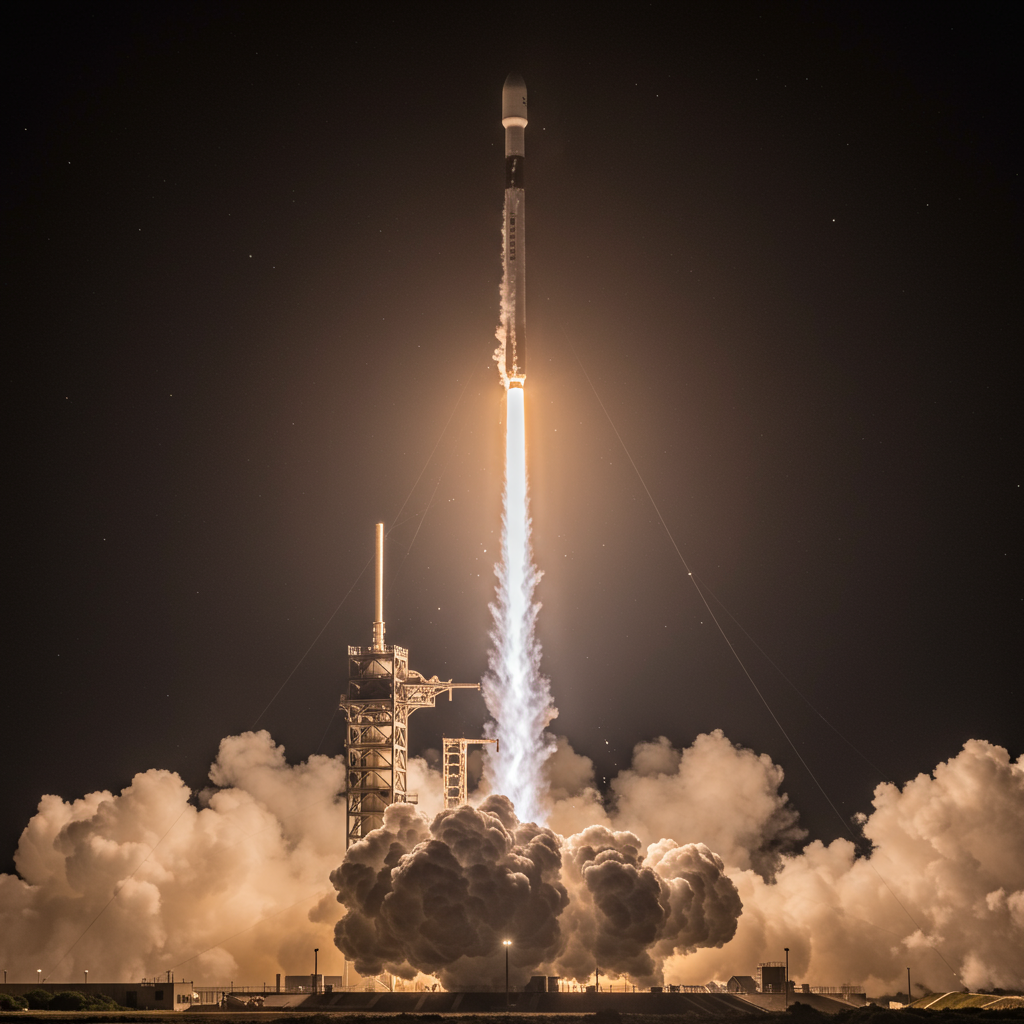In a rare operational move, SpaceX launched Spain’s advanced SpainSat NG-2 communications satellite, opting to expend its veteran Falcon 9 first-stage booster. This strategic decision, driven by the demanding performance requirements of the mission, underscores the critical value of the payload. The successful deployment on October 24, 2025, from Florida’s Space Coast, marks a significant step for Spain’s national security and places its space industry at the forefront of European innovation in secure communications.
The Falcon 9’s Singular Mission: SpainSat NG-2 Soars
On October 24, 2025, a SpaceX Falcon 9 rocket soared into the pre-dawn sky from Space Launch Complex 40 at Cape Canaveral Space Force Station. The mission, operated for Spain-based Hisdesat, successfully delivered the SpainSat NG-2 communications satellite into orbit. This launch, initially delayed by 24 hours for undisclosed reasons, proceeded flawlessly once the four-hour launch window opened at 9:30 p.m. EDT (0130 UTC). Weather conditions were highly favorable, boasting a greater than 95 percent chance of clear skies.
The deployment of SpainSat NG-2 was confirmed more than 35 minutes after liftoff. This satellite represents a pivotal asset for Spain, designed to bolster its secure communication capabilities for years to come. The mission highlights the robust partnership between Hisdesat and SpaceX, ensuring vital infrastructure reaches its intended orbital destination.
Why SpaceX Opted for an Expendable Flight
The decision by SpaceX to expend the Falcon 9 first-stage booster for the SpainSat NG-2 mission was a notable departure from its celebrated reusability model. This particular booster, B1076, had a remarkable 20 prior flights before this 21st and final journey. SpaceX explicitly stated that an expendable flight was necessary “due to the additional performance required to deliver this payload to orbit.”
Maximizing the rocket’s lift capacity was paramount. To achieve this, the booster was not fitted with landing legs or grid fins. These components, standard for reusable missions, add significant weight. Their removal allowed the Falcon 9 to dedicate more thrust and fuel to the payload, ensuring it reached the precise, demanding geosynchronous transfer orbit (GTO). While the first stage was not recovered, the two halves of the payload fairing were expected to be retrieved after parachuting into the Atlantic Ocean.
This contrasts sharply with SpaceX’s typical operations. For example, recent Starlink missions saw boosters like B1075 complete its 21st flight and B1067 set a new record with its 31st flight, demonstrating unparalleled reusability. The vast majority of SpaceX’s 520+ successful booster landings underline its commitment to cost-effective space access. The SpainSat NG-2 mission, therefore, stands out as a clear example of prioritizing mission-critical performance over routine booster recovery when specific orbital mechanics demand it.
Spain’s Next-Generation Shield: The SpainSat NG-2 Satellite
The SpainSat NG-2 satellite is a sophisticated piece of technology designed for a 15-year operational life. Fully fueled, it boasts a substantial mass of 6.1 tons (13,448 lbs.). After its initial deployment into a geosynchronous transfer orbit, the satellite will autonomously maneuver itself into its final geostationary orbit.
Built on Airbus Defence and Space’s robust Eurostar Neo satellite bus, SpainSat NG-2 features an impressive wingspan of nearly 50 meters (164 ft.). This advanced design enables its multi-band communication capabilities. Funding for this crucial national asset included a significant 74 million euro ($86 million) investment. This came from Spain’s Ministerio de Ciencia, Innovación y Universidades (Ministry of Science, Innovation and Universities), channeled through the Agencia Espacial Española (Spanish Space Agency) and the Centro para el Desarrollo Tecnológica y la Innovación (Center for Technological Development and Innovation).
A Network of Security: Strategic Importance and Capabilities
The primary mission of SpainSat NG-2 is to provide highly secure communications for the Government of Spain. However, its strategic importance extends beyond national borders. Hisdesat, the satellite’s operator, will also offer its functionality to the European Union via the Govsatcom program and to NATO, significantly enhancing collaborative defense and security capabilities.
This advanced satellite operates across X-, Military Ka- (Ka Mil-), and Ultra-High Frequency (UHF) bands. Airbus Defence and Space was responsible for developing the X-band payload. Thales Alenia Space’s Spanish office meticulously crafted the Military Ka-band and UHF-band payloads. Together, SpainSat NG-2 and its twin, SpainSat NG-1, will deliver comprehensive coverage. This vast network stretches from the United States in North America all the way to Singapore in Asia.
Minister of Science, Innovation and Universities, Diana Morant, highlighted the satellite’s impact. She stated that it positions the Spanish industry at the very top of Europe. She praised its role in advanced secure communication systems, calling it “the most innovative and advanced communications satellite on our continent.” Morant underscored its significance as a tangible demonstration of the Ministry’s commitment to development, progress, and innovation within Spain.
The SpainSat NG Constellation: A Dual Approach
SpainSat NG-2 is the second of a pair of geostationary satellites for Hisdesat, forming a resilient and comprehensive communication constellation. Its predecessor, SpainSat NG-1, was launched on January 29, 2025. Interestingly, that mission also utilized an expended Falcon 9 rocket. SpainSat NG-1 began its operations at the 30 degrees West orbital position on August 11, 2025.
With SpainSat NG-2 slated to operate at 29 degrees East, the two satellites create a powerful, geographically dispersed network. This dual approach ensures redundancy and expanded coverage for critical secure communications across continents. Both satellites are engineered for the same robust 15-year nominal operating life, providing long-term strategic capabilities.
SpaceX’s Unrelenting Cadence in 2025
The launch of SpainSat NG-2 further solidifies SpaceX’s incredibly busy 2025 launch schedule. This mission marked the 134th orbital launch for the company within the year. This achievement alone ties the total number of launches SpaceX completed throughout all of 2024. The company has set an ambitious target for itself, hoping to surpass 170 launches by the end of 2025.
This unrelenting pace is largely fueled by the continuous deployment of its Starlink internet constellation. However, SpaceX also supports a diverse range of clients, including critical government and military missions. For instance, recent Falcon 9 flights have launched Starlink batches like the 11-5 mission (550th Falcon 9 overall) and the 10-17 mission, which saw a booster complete a record 31st flight. Other missions included sensitive payloads for the Space Development Agency’s Tranche 1 Transport Layer, showcasing the versatility and reliability of the Falcon 9 across various demanding applications.
Frequently Asked Questions
What makes the SpainSat NG-2 mission unique for SpaceX?
The SpainSat NG-2 mission stands out because SpaceX made the rare decision to expend its Falcon 9 first-stage booster (B1076). Unlike the vast majority of its launches, where boosters are recovered for reuse, this mission prioritized maximum payload performance. The booster was stripped of landing legs and grid fins to save weight, allowing it to deliver the heavy, 6.1-ton satellite to a precise geosynchronous transfer orbit. This choice highlights the critical importance of the SpainSat NG-2 payload.
Which organizations benefit from the secure communications provided by SpainSat NG-2?
SpainSat NG-2 primarily serves the secure communication needs of the Government of Spain. However, its capabilities extend to international partners. Hisdesat, the operator, also offers its advanced functionality to the European Union through the Govsatcom program and to NATO. This wide reach makes SpainSat NG-2 a vital asset for cooperative defense and security initiatives across Europe and beyond.
What are the engineering reasons behind expending a Falcon 9 booster for a launch like SpainSat NG-2?
SpaceX expends a Falcon 9 booster for missions like SpainSat NG-2 when the payload’s mass and desired high-energy orbit require the rocket to operate at its absolute maximum performance. Recovering a booster demands propellent reserves for the landing burn and incurs the weight of landing legs and grid fins. By eliminating these, the rocket can carry more fuel for the ascent and final orbital insertion, ensuring the satellite reaches its very specific and demanding geosynchronous transfer orbit. This is a trade-off where mission success for a critical payload outweighs the reusability benefit.
Conclusion: Looking Skyward for Secure Futures
The launch of SpainSat NG-2 is more than just another rocket soaring into space; it represents a significant advancement in secure communications and international defense capabilities. While marking a rare expendable mission for SpaceX, it underscores the paramount importance of the satellite’s mission. Spain, with its investment and innovative technology, has secured a vital asset that will enhance its national security and contribute significantly to the broader security frameworks of the European Union and NATO. As SpaceX continues its record-setting launch cadence, the deployment of sophisticated satellites like SpainSat NG-2 ensures that critical infrastructure, both commercial and governmental, continues to reach orbit, fostering a more connected and secure future.




